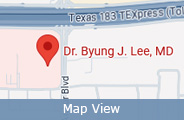Proximal Biceps Tendon Injuries
The biceps muscle, located in the front of the upper arm allows you to bend the elbow and rotate the arm. Biceps tendons attach the biceps muscle to the bones in the shoulder and in the elbow. Biceps tendon rupture at the shoulder joint is referred to as proximal biceps tendon rupture and rupture at elbow joint is known as distal biceps rupture.
Biceps tear or rupture can be complete or partial. Partial biceps tendon tears will not completely break the tendon. Complete tendon tears will break the tendon into two parts.
Proximal biceps tendon rupture: Two tendons that attach the biceps muscle to the bones in the shoulder, the long head tendon that attaches the muscle to the top of the shoulder’s socket (glenoid) and the short head that attaches it to the shoulder blade. Tears are more likely to occur in the long head of the biceps tendon. Tears of the short head of the biceps are very rare. But even in case of a complete tear of the long head, the short head of the biceps may allow you to continue using your biceps muscle.
Biceps tendon tear can be caused by injury such as falling down with your arm outstretched or during the act of lifting heavy objects. In case of overuse, a tendon may fray and eventually tear. Other shoulder problems such as tendonitis, shoulder impingement, and rotator cuff injuries are more likely to weaken or tear the biceps tendon. Additional risk factors such as advancing age, heavy overhead activities, repetitive overhead sports, smoking, and use of corticosteroids can also result in a tendon tear.
The most common symptom is a sudden, severe pain in the upper arm or at the elbow, depending on where the tendon is injured. At times you may hear a “pop”. Other symptoms include swelling, visible bruising, weakness in the shoulder or elbow, and trouble turning your arm palm or palm down. A bulge referred to as a “Popeye Muscle,” may also appear in your arm, because the tendon is no longer holding the muscle in place properly.
Biceps tendon tear is usually diagnosed based on your symptoms, medical history, and physical examination. During the physical examination, your doctor will look for a gap in the front of the elbow. Your doctor will diagnose a partial tear by asking you to bend your arm and tighten the biceps muscle. You may have pain if there is a partial tear. X-rays may be taken to rule out other conditions causing shoulder and elbow pain. Using an MRI scan your doctor can know whether tear is partial or complete.
Conservative treatment for a proximal biceps tendon tear includes ice application, limiting activity, non-steroidal anti-inflammatory medications to reduce the pain and keep down the swelling. To restore the mobility and strengthen of the surrounding muscles, your doctor may prescribe certain flexibility and strengthening exercises. Surgery to reattach the torn tendon back to the bone is rarely needed. However, for patients with partial tears who continue to experience symptoms after non-surgical treatments or who want all of their arm strength back, such as athletes or manual laborers, surgery may be the best option. Complications are rare and a re-tearing of the repaired tendon is rare. Following surgical repair, you will need to do flexibility and strengthening exercises to improve the range of motion in your shoulder.
2001 N MacArthur Blvd
Suite 630
Irving, TX 75061
 Ph: (469) 800 7200
Ph: (469) 800 7200
 Fax:
(469) 800 7210
Fax:
(469) 800 7210

 Make an Appointment Online
Make an Appointment Online

 Shoulder
Shoulder Elbow
Elbow Wrist
Wrist Hand
Hand Patient Education
Patient Education Testimonials
Testimonials Map
& Location
Map
& Location Patient Forms
Patient Forms






